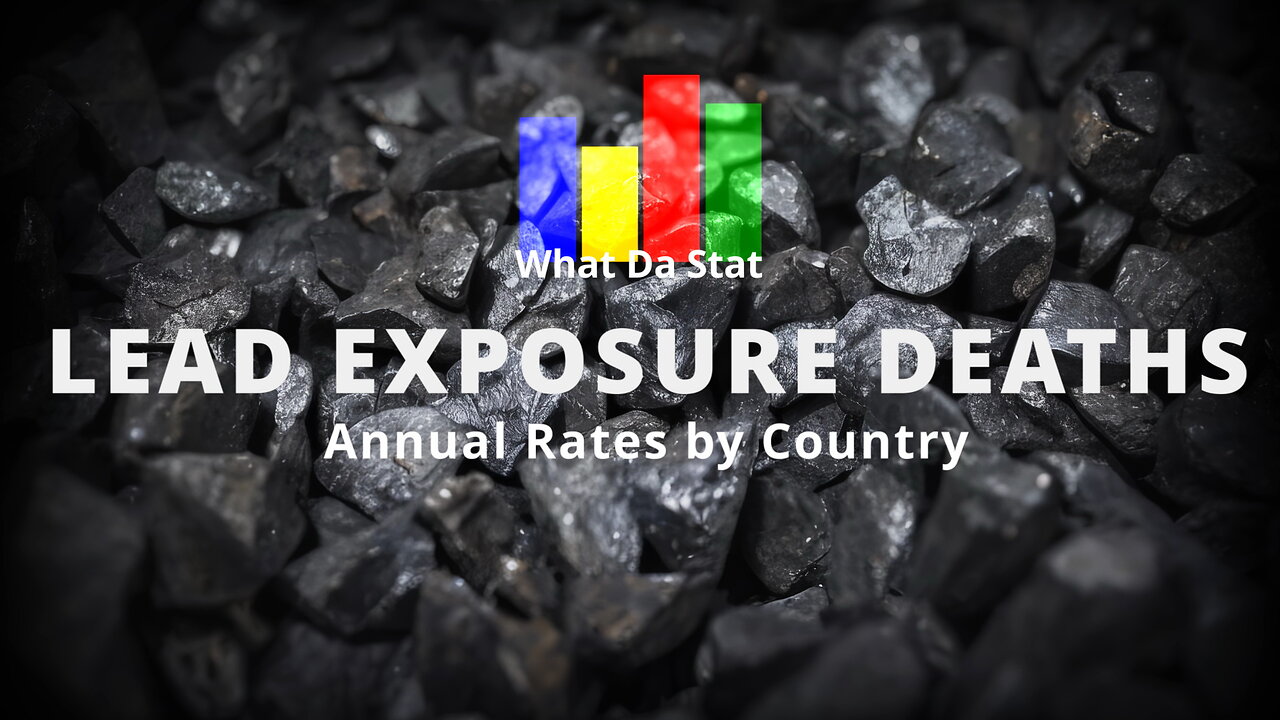Premium Only Content

Deaths Rates from LEAD Exposure by Country and World
This bar chart race shows the annual death rates from lead exposure by country and world, from 1990 to 2019, per 100,000.
Lead, a highly toxic heavy metal, has been used in various industrial and household applications for centuries, but its adverse health effects have only come to light in recent decades. Tragically, exposure to lead continues to claim lives, affecting populations across the globe, irrespective of geographical boundaries.
Causes of Lead Exposure:
Lead exposure primarily occurs through ingestion, inhalation, or skin contact with lead-based products or contaminated substances. Some common causes of lead exposure include:
Paint and Dust: In the past, lead-based paint was widely used, and older buildings still contain layers of lead paint that can deteriorate over time, releasing lead dust into the air. Children living in such environments are particularly vulnerable to lead poisoning when they inhale or ingest this dust during play.
Drinking Water: Lead can leach into drinking water from old plumbing systems, lead pipes, or fixtures made with lead solder. Prolonged consumption of contaminated water can lead to severe health consequences.
Occupational Exposure: Workers in industries like mining, battery manufacturing, and recycling are at risk of lead exposure due to their proximity to lead-containing materials or processes.
Soil Contamination: Lead particles from industrial activities, emissions, or leaded gasoline can contaminate soil. This contamination can pose a threat, especially in urban areas or near industrial sites.
Geographical Distribution:
Lead exposure is not limited to a specific region but can be found across the globe. However, the prevalence and severity of lead poisoning vary based on socio-economic factors, industrialization, and regulation. Some regions are disproportionately affected:
Developing Nations: Many low and middle-income countries lack stringent regulations on lead usage and disposal, leading to higher exposure levels. Inadequate healthcare facilities may also contribute to higher mortality rates in affected areas.
Industrial Hubs: Regions with a history of heavy industries, such as mining, smelting, and manufacturing, may have elevated lead levels in their environment, impacting the health of local residents.
Urban Centers: In densely populated urban areas, aging infrastructure and buildings with lead-based paint can exacerbate the risk of exposure, especially for children living in poorly-maintained housing.
Impact on Health:
Lead exposure can have severe consequences for human health. Children and pregnant women are particularly vulnerable, as lead can hinder cognitive development, cause learning disabilities, and impair neurological functions. Adults can experience cardiovascular issues, kidney damage, and reproductive problems due to lead exposure. In extreme cases, lead poisoning can be fatal.
Prevention and Awareness:
Addressing deaths caused by lead exposure requires a multi-faceted approach:
Regulation: Governments must enforce strict regulations on lead usage in industries, paints, and products. Additionally, monitoring water quality and addressing lead contamination in old infrastructure is crucial.
Public Awareness: Raising awareness about lead exposure, its sources, and preventive measures is vital in empowering communities to protect themselves.
Remediation: Remediation efforts should focus on cleaning up lead-contaminated sites and promoting lead-safe practices in construction and renovation projects.
Health Interventions: Timely medical interventions, such as chelation therapy for severe cases of lead poisoning, can save lives and reduce long-term health impacts.
In conclusion, the tragic deaths caused by lead exposure remain a pressing global issue. The indiscriminate nature of this toxic metal demands collective efforts from governments, industries, healthcare professionals, and communities alike to mitigate its deadly effects. By prioritizing prevention, regulation, and education, we can hope for a future where lead exposure becomes a distant memory, sparing countless lives from its toxic grip.
Source: Global Burden of Disease Collaborative Network. Global Burden of Disease Study 2019 (GBD 2019) Results. Seattle, United States: Institute for Health Metrics and Evaluation (IHME), 2021.
Music: Darren Curtis - Predator or Prey
https://soundcloud.com/desperate-measurez/dark-chimes-and-vocals-predator-or-prey-royalty-free-horror-theme
Data visualization created with flourish.studio and AI
-

StoneMountain64
7 hours agoBattlefield 6 Learn to FLY Gameplay
114K3 -
 LIVE
LIVE
Joker Effect
1 hour agoKick / Stake Are Accused of Racketeering! What Does This Mean For Gaming On Rumble?
489 watching -
 43:24
43:24
RiftTV
4 hours agoSILENCED by MSM? Dr. Drew Examines Political Shift & Gives CURE For EXTREMISM | Guest: Dr. Drew
39.4K1 -
 2:14:10
2:14:10
vivafrei
10 hours agoEp. 286: Letitia James INDICTED! Bolton in Trouble! Senate Being Spied On! Gaza Ceasefire & MORE!
76.8K106 -
 12:39
12:39
Tundra Tactical
7 hours ago $15.82 earnedTundra Meme Review - Gun Meme Finds Of The Week
28.3K7 -
 LIVE
LIVE
IsaiahLCarter
8 hours ago $0.60 earnedBlack People FIRED as Democrat Serf Class || APOSTATE RADIO 031 (GUEST: Michael D.C. Bowen)
60 watching -

EricJohnPizzaArtist
4 days agoAwesome Sauce PIZZA ART LIVE Ep. #65: “The Schleppy”
20.4K4 -
 22:59
22:59
Tactical Advisor
6 hours agoTransforming Axe?! | Vault Room Live Stream 041
66.6K7 -
 LIVE
LIVE
Spartan
4 hours agoOMiT Spartan | Ranked and/or 8s, God of War, or all 3. Idk
13 watching -
 10:35
10:35
Sponsored By Jesus Podcast
3 days ago $18.51 earnedDo I Really Need Church? | Spiritual Family & the Body of Christ
73K52